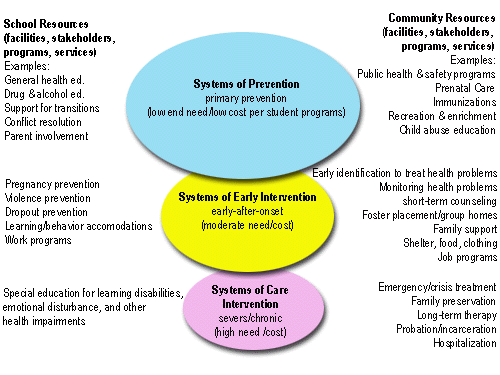

In broadening the focus to the many efforts to address barriers to and enhance healthy development and learning, Systems of Care represent one end of a continuum. Viewed through the lens of addressing barriers to learning, an essential range of interventions encompasses a comprehensive, integrated continuum of community and school programs for localities. The framework for such a continuum emerges from analyses of social, economic, political, and cultural factors associated with the problems of youth and from reviews of promising practices. It encompasses a holistic and developmental emphasis. Such an approach requires a significant range of programs focused on individuals, families, and the contexts in which they live, work, and play. Such a continuum ranges from primary prevention and early-age intervention, through approaches for treating problems soon after onset, to treatment for severe and chronic problems.
Ultimately, all this must be viewed from a societal perspective and must include programs designed to
Implied is the importance of using the least restrictive and nonintrusive forms of intervention required to address problems and accommodate diversity. With respect to concerns about integrating activity, the continuum of community and school interventions underscores that interprogram connections are essential on a daily basis and over time. That is, the continuum must include systems of prevention, systems of early intervention to address problems as soon after onset as feasible, and systems of care for those with chronic and severe problems. And each of these systems must be connected seamlessly (see Figure below).
AIMS:
To provide a CONTINUUM OF SCHOOL AND COMMUNITY PROGRAMS & SERVICES
To ensure use of the LEAST INTERVENTION NEEDED

|
School Mental Health Project-UCLA WebMaster: Perry Nelson (smhp@ucla.edu) |
 |